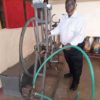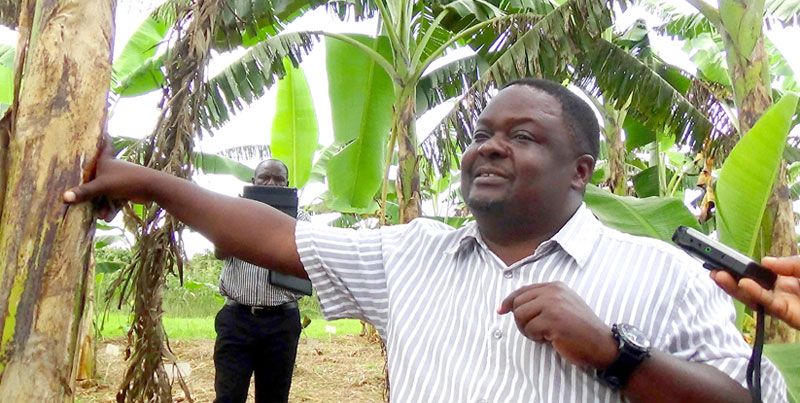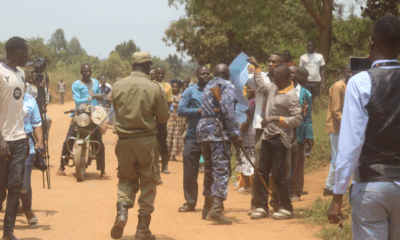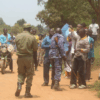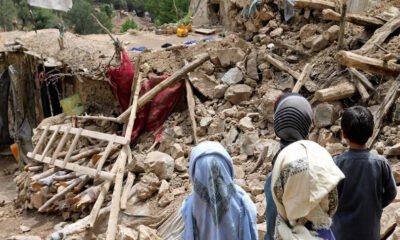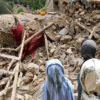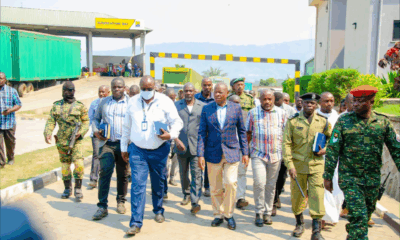Neglected research centre struggles to remain relevant

Nassari Greenhouse
Founded in 1920 by the British as a centre of research focusing on crops for the Semi-Arid zone of Northern and other drier parts of Uganda, NaSARRI has degenerated into a shadow of its glorious past.
As part of a group of journalists under the Biosciences for Farming in Africa (B4FA) programme, we recently visited the research station to witness the activities carried out at the sprawling 1700 acre firm, which is one of the 15 national agricultural research systems.
A 130kms of bumpy and dusty ride led us from Mbale to Serere, a remote trading centre and the headquarters of the newly created district of Serere, where we spent a night at Alisa Guest House.
A small muram road leading to the research station was lined with staff houses whose roofs were invaded by algae since many years ago, thanks perhaps to neglect by the occupants and the management.
Vehicles grounded

One of the vehicles grounded
A sense of deeper malaise however became more apparent as we got closer to the administration block. The parking lot was filled with decaying ploughs and vehicles that seemed relatively new, were it not for neglect. On second thought however, this scene is all too familiar in courtyards of government institutions and is often blamed on ‘lengthy’ procurement processes. Authorities here gave the same old cliché that repairing the vehicles would be more costly to the taxpayer than buying new ones.
The rest of the buildings looked deserted and dilapidated. With no functioning laboratory, weather station, screen house, one wonders whether research done at this place can move Uganda into the middle income category as envisioned in the Vision 2040.
More realistically, the absence of an enabling environment at this research station casts a darker shadow on its ability to provide solutions to the rapidly emerging human and environmental challenges including rapid population growth, climate change and rampant disease outbreaks.
As the head of the institute, Dr. Beatrice Akello, explained, the institute is crippled by a severe funding shortfall. According to Akello, her institution receives just under half of its annual financial requirements. As a result, she explains, the little available funds are spent on salaries and transporting scientists who traverse the vast rugged terrain of North and Eastern Uganda for field outreach activities including engaging farmers.
The rest of the money is used for maintaining the institute’s vast land used for field trials. Because of the absence of gene bank, the institute endures the trouble and cost of having to plant out crops every season as a way of preserving the genetic material of the ten different crops upon which the station focuses its research activities.
According to Dr. Akello, the institute submits an annual budget of about 5 billion shillings every year, out of which it receives just 2 billion. She blames the recurrent funding shortfall as a source of despairer for the few scientists who brave the unfavourable conditions compounded by lack of access to modern labs, reliable electricity or even access to better social services like schools and health centres.
“The institute is one of the biggest in the country, but we don’t have labs. Many of the scientists we want to hire have trained in western countries and had access to modern labs. They find it extremely difficult to work in these conditions.
According to Akello, the collapse of the institute’s seed bank years ago, was caused by constant power outages, but also due to funding shortfalls that made the use of a generator unsustainable.
Obsolete facilities

Nassari seedbank
The institute’s poor research infrastructure is compounded by the lack of basic amenities for scientists including the lack of decent housing, lack of access to good health and educational services for staff members and their families.
Akello made an impassioned plea to relevant authorities while talking to visiting B4FA journalists when she said: “Something must be done about housing. It is a major problem that discourages many researchers from coming here.”
The lack of houses forces majority of the researchers to commute to and from Soroti to the institute in Serere, a 30km unpaved road simply because it’s in Soroti where they can access decent housing besides better health and educational services for themselves and their families.
The unenviable state of staff welfare as well as poor working conditions at Serere’s NaSARRI has therefore deprived the institute of skilled workforce who would have helped it deal with numerous challenges affecting the 10 different crops that the station focuses on.
Absence of basic research facilities have condemned the institute into an orphaned organisation that thrives mainly on primary work of other research organisations notably, the International Crops Research Institute for the Semi-Arid Tropics.
This is evident in many crops including Sorghum and Millet where the institute has recorded the biggest successes. According to John Emanio, a Research Technician on Sorghum breeding, the scientists are forced to resort to conventional breeding methods that take years to yield results.
As Roberty Amayo, a plant pathologist and head of the dryland legumes programme adds, lack of modern equipment limits their ability to use faster plant breeding techniques such as marker-assisted breeding. As a result, he argues, they are unable to respond to needs of their customers and stakeholders in a timely manner, let alone deal with ever-changing disease and weather conditions.
Dr. Akello sounds even more frustrated by the fact that a number of concerned persons including members of Parliament on the agriculture committee have visited the station and have apparently not given the matter the urgency it deserves.
“We have received many relevant people including Members of Parliament to whom we explain our plight but nothing seems to be happening,” a frustrated Akello said.
While the long distance from Kampala to Serere would lead one to attribute the government’s neglect, the country’s research infrastructure as a whole is not that pleasant anyway.
Despite the many harsdships they face, the institute has registered some successes including the development of high-yielding, fast maturing and drought resistant varieties in a number of crops such as sorghum, ground nuts, millet and cow peas, pigeon peas.
NaSARRI scientist George Ebyau has been accredited for developing popular high-yielding drought escape Sorghum varieties used by two leading beer producers in Uganda. The same varieties have also helped to improve the incomes of many people in the region since they fetch better returns than previous varieties.
In recognition of their hard work and resilience perhaps, the institute has been nominated for the Presidential Science Initiative Award for this year.
This is evident at the National Agricultural Research Laboratories (NARL) in Kawanda, located about five kilometres from the capital city as well as at National Crops Resources Research Institute (NaCRRI) in Namulonge. Both NARL and NaCRRI have only recently witnessed a boost in infrastructure capacity mainly because of donor funding. The two institutes have in recent years received modern biotechnology laboratories and other research facilities thanks to funding from the US and Japanese governments.
Indeed, a great number of agricultural scientists in Uganda today owe their successes to funding for academic and other purposes, from internationally recognised philanthropic organisations like the Bill and Melinda Gates foundation.
While apparently seeming appreciative of the achievements of Ugandan agricultural researchers, President Museveni’s government has demonstrated little enthusiasm to use the vast skilled human resource in the field of agricultural research to transform Uganda’s largely subsistent and low productive agriculture.
Despite the vital role agriculture plays in the economy as the largest employer and source of livelihoods for over 70 percent of the population, President Museveni’s government continues to aspire to allocate 1 percent of her resources devoted to research.
While officiating at a recent conference on the Biotechnology and Biosafety Bill, Finance Minister Matia Kasaija said the government was committed to raising funding for infrastructure development in the sector.
But Kasaija’s promises were dampened by reports that the government has resisted pressure to allocate a ministry in charge of science and technology that would consolidate the various scattered research functions into a single ministry which would also push the govenrment to live up to its commitments as well as challenge of allocating substantial resources to research and development.
Uganda’s situation reflects Africa’s generally meagre investments in agricultural research and modernisation, which according to several international agencies and scholars, is a pre-requisite for economic transformation.
Writing in his book; The New Harvest, Agricultural Innovation in Africa, Kenyan-born Harvard Professor Calestous Juma argues that increasing investments in agricultural research and extension services in Africa offers the greatest rate of return of return of 35% percent, compared to 15-20% return from irrigation projects.
Juma cites China and and India, as inspiring examples of how significant investments in agriculture coupled with entrepreneurship have turned those countries from bastions of hunger and poverty to zones of economic growth and prosperity.
Comments




